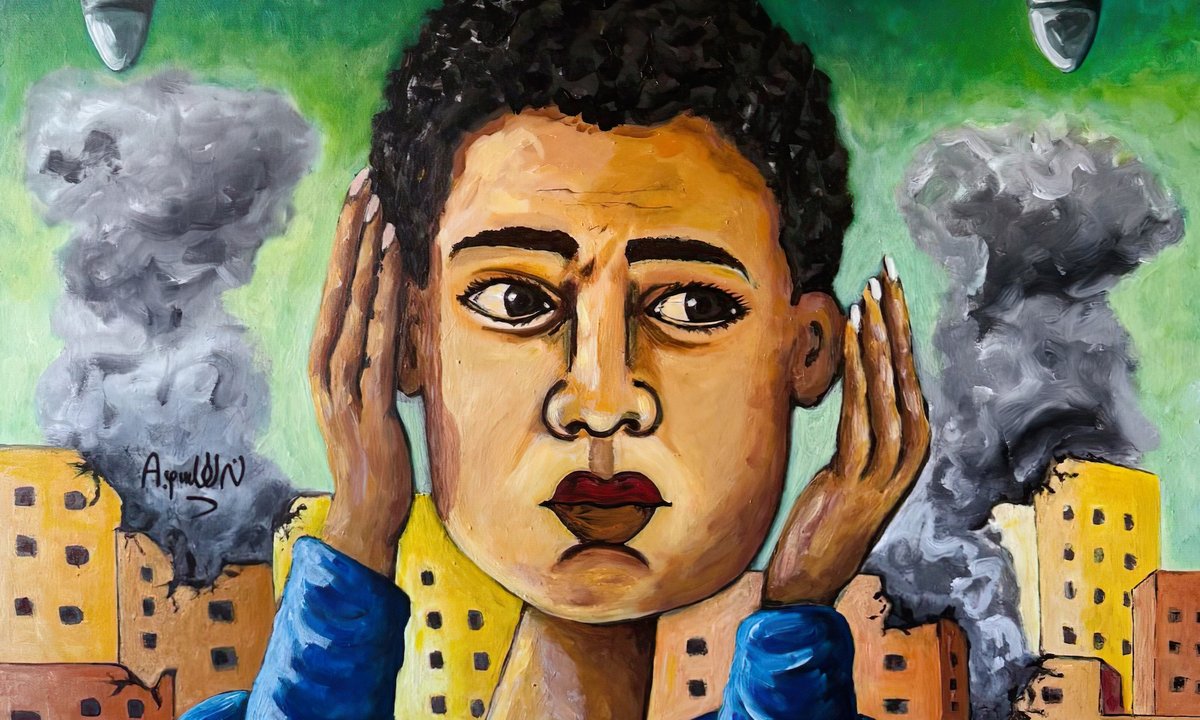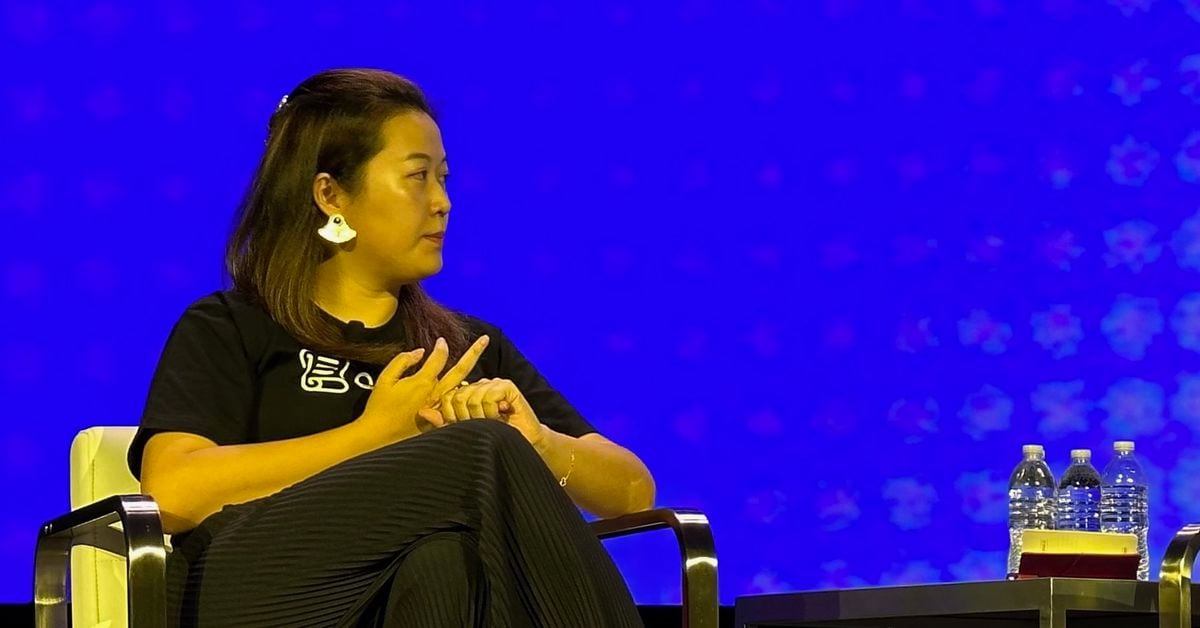The artist duo Nathalie Djurberg and Hans Berg celebrate 20 years of working together this year—mostly making short stop-motion films of what are probably best described as fucked-up fairy tales with mesmerising techno soundtracks. In the works, anthropomorphic and sometimes grotesque crocodiles, snakes, wolves, pigs, birds, young women and menacing men play out disturbing and violent taboos around pain, anguish, power, desire, repulsion and shame. The scenarios are simultaneously humorous and sinister, teasing out the subconscious through a strange kind of surrealism. The works create a unique juxtaposition between a medium most often associated with children’s programming and themes that are certainly not for kids.
Each film takes between a couple weeks to several months to create, with Djurberg in charge of the visuals, while Berg composes the music. Over the years, they have melded their roles somewhat (“I sometimes dream about the music Hans makes,” Djurberg tells The Art Newspaper). Both artists are originally from Sweden and largely self-taught—Djurberg went to art school for painting, but she figured out stop-motion animation on her own. They met in Berlin in 2004, where they lived and worked together for 15 years. No longer a couple romantically, they remain very close. “We are very different, but in certain ways we almost look like each other,” Djurberg says.
Djurberg now has a young son, who sometimes plays in the studio, in the sets and even with the characters, although the artist says she would never show him the completed animations. Djurberg is the first to admit that motherhood has softened her somewhat. An exhibition of new works currently on view at the National Nordic Museum in Seattle (until 27 October) explores this change. “The exhibition space was like a fjord,” Djurberg says. “It’s like a flood washed up the debris that has created its own life.” Populating this unusual landscape are sculptures of rocks, strange flowers and anthropomorphic branches and eggs, accompanied by a triptych of projected short films.
“It’s so hard to describe a sculpture without it sounding mundane,” Berg says. “If you want to describe something, the description has to be bigger than what you want to describe. You can’t say it’s rocks with flowers and an egg. That’s not all it is. It’s very hard to say with words, but we wanted to make a world. And you go through this world where things are washed up and…”
“…and sort of underwent a metamorphosis,” Djurberg adds.

Installation view of Nathalie Djurberg & Hans Berg: A Place of Opportunity and Transformation, National Nordic Museum, Seattle Photo: Jim Bennett/Photo Bakery for the National Nordic Museum
The Art Newspaper: How have your work and working styles changed or developed in the two decades that you have been making art together?
Hans Berg: In the beginning, Nathalie was making the videos and when she finished them, I’d compose the music. It was very clearly divided. But then over the years, it’s been much more of a collaboration, and the music is integrated into the work. We discuss all the works, films, sculptures and installations together. We still have our separate roles, but we work together on the concept. I also work in the studio with her on sculptures, even though she’s the main sculptor. But Nathalie discusses the music with me as well, so it’s much more of a collaboration now.
Nathalie Djurberg: That happened sort of seamlessly, because we were working together when we were living together. We were a couple. It was rare that we were not together. We developed our own language. When you get to know someone and their process so well, after a while it merges—when you breathe the same air and eat the same food. We started talking about the creative process almost like it’s its own entity. I have my own creative process and Hans has his, but between us, there is something else that emerges that is sort of wordless. I really like that part of our collaboration.
HB: When we work together, things fall into place easily and we both know when something is right.
ND: There’s no unnecessary talking.
HB: That’s such a Swedish thing to say.
Speaking of Swedish things, how have Scandinavian folklore and music influenced your work?
ND: Early childhood lays the groundwork for people, and I was brought up on fairy tales. I was fascinated with them. No matter how much of that may come through in the work, it is always there—that groundwork becomes a language or a lens you can express yourself through as an artist or a creative person. I know that for Hans, it’s a little bit different, because he wasn’t brought up on fairy tales, but he had folk music.
HB: I did. Where I grew up, there was a lot of folk music. My mom played a bit, and my grandfather was a folk musician. I hated the music at the time, but it’s now such a big part of me. And then the reason I moved to Berlin was the electronic music scene. Often, I mix these two very big musical influences in our animations—the folk music, which I got whether I wanted it or not, and the electronic music that I sought out.
ND: Hans taught me to enjoy and appreciate techno and a broader spectrum of music. He is more accepting than I am of everything. He likes more art than I do. He likes more music than I do. He likes food more. I’m just a picky eater with everything. I had to be taught to appreciate electronic music. But it’s the same way you might not like olives when you’re little but you learn how to like them, and because it was not something easy to like, you appreciate them even more.
Where do the ideas come from for your scenarios and characters? Do you have a specific plot line at the start, or do you figure it out as you go?
ND: The plot always comes first, and the plot is basically the idea. Sometimes it’s very clear exactly what I want to do and I’m finding the way to do it. At least until I got pregnant, I had a really good memory, so I didn’t have to write anything down. But I also appreciate that if I haven’t written it down, it’s not set in stone. If there is a fork in the road while I’m making the animation, if I haven’t written it down, it’s easier to take the other road and see where it leads. I love when I’m working on something and it’s suddenly so obvious that it should go in a certain direction. I’m like a silent observer of what is taking place—not always silent, but I’m just the observer. I’m also the one who is experiencing the idea in the making of it. And that is fascinating to me.
HB: The characters are a manifestation of the idea. They’re not like people; it’s the other way around. Something happens, and it’s clear which character best illustrates that.
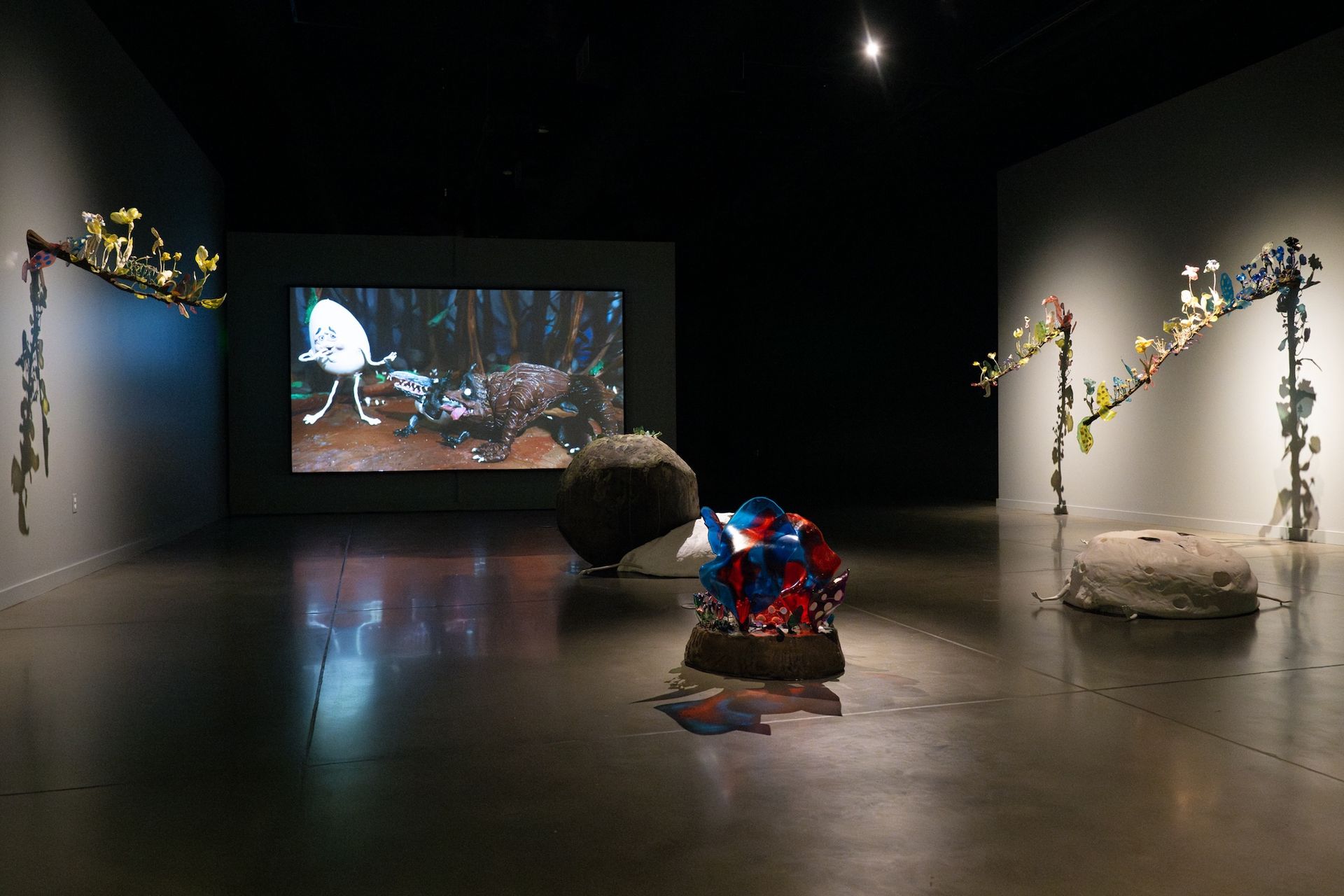
Installation view of Nathalie Djurberg & Hans Berg: A Place of Opportunity and Transformation, National Nordic Museum, Seattle Photo: Jim Bennett/Photo Bakery for the National Nordic Museum
You use a lot of birds as characters. What is your attraction to birds specifically?
ND: I like birds because when I first started working with them, they didn’t have much emotional baggage for me. They could be whatever.
HB: They’re kind of characterless, like a living painting.
ND: And you can make them into a character if you choose. Now I think birds have character, but when I started out, it was really just the freedom of using them as a blank canvas. It was so gratifying to be able to use them however I wanted.
What kind of materials do you use to make your characters?
ND: I use whatever material is necessary. When I started out, I used whatever I could afford and I would reuse everything. As soon as I had used a character, I would tear it down and reuse the materials. Basically, it’s wire plus some form of material that cures, and plasticine for the soft parts. Wooden marbles for the painted eyes that can move and whatever else I can find. Sometimes they have fabric clothing. It’s always whatever is necessary to make the idea. If a certain material is tricky, I won’t use it much unless I really need to. But then I will start to like it, and it becomes easier to work with it. It’s the same with ideas: the idea comes first, and then the rest drags behind. You want to do something and don’t know how, so you have to find a way to make it, which is also interesting because learning to work with a new material can lead to new ideas. You might not have had the language material-wise to express an idea before, so that idea didn’t come until you had the means to make it. I think this is really interesting—what comes first and how they affect each other.
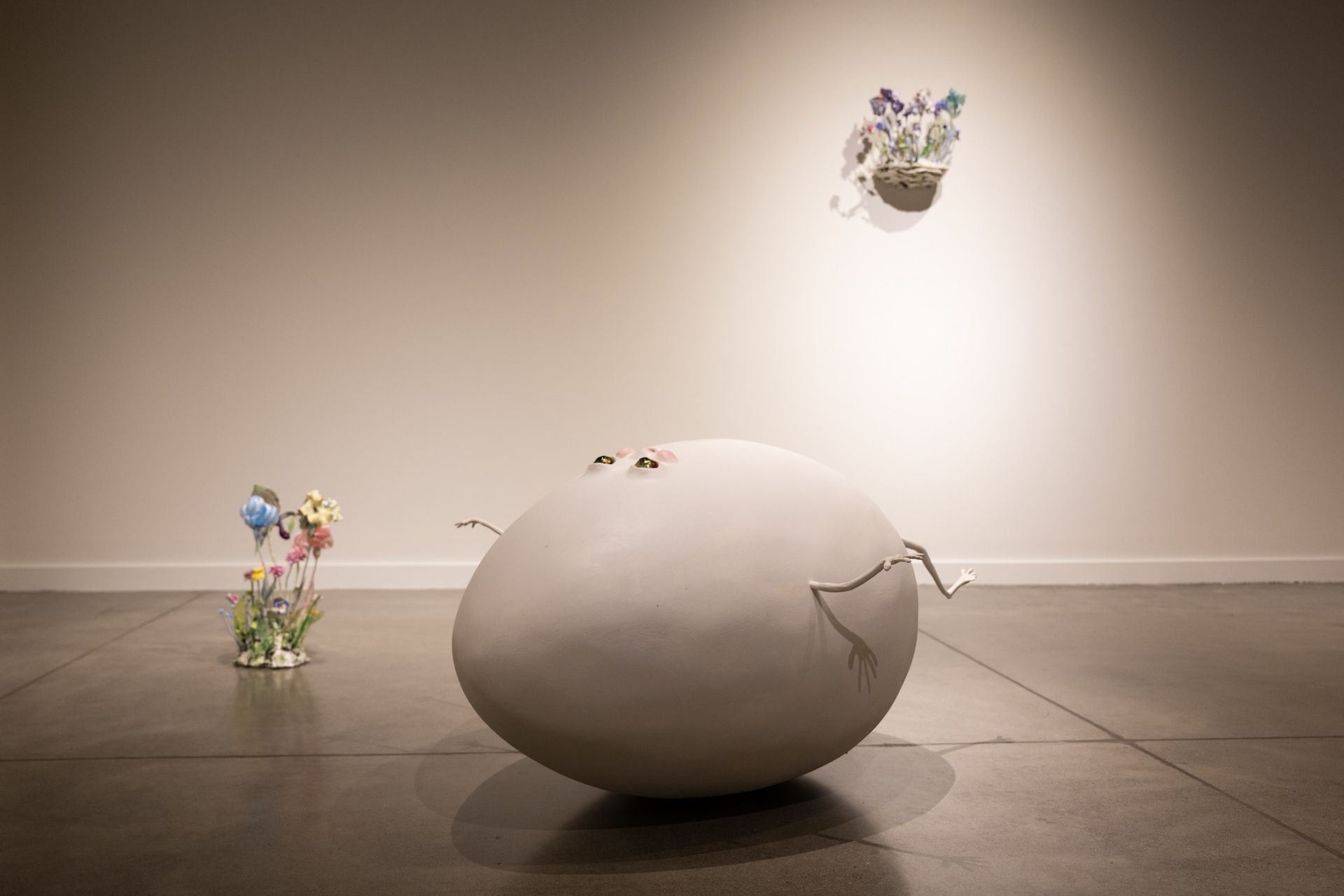
Installation view of Nathalie Djurberg & Hans Berg: A Place of Opportunity and Transformation, National Nordic Museum, Seattle Photo: Jim Bennett/Photo Bakery for the National Nordic Museum
Do you ever use the same melodies or themes for similar scenarios?
HB: Never, except the three films we’re showing now in Seattle. Those are like a triptych. And it’s not the same music, but I made it in the same tempo, the same key and used the same instruments, because I wanted these films to be able to play together in a single space. But that’s the one time I used exactly the same set of instruments. Otherwise, it’s the same as with the characters: for each new idea, we need a new set of instruments.
Are there particular characters that might evoke a certain type of music or instrumentation—like a Peter and the Wolf situation, where each is represented by a different instrument? Or does the music serve as more of a general mood?
HB: Peter and the Wolf is a good example, because with the Seattle triptych, I gave each character one instrument that plays through their whole story. So the pig had one instrument, the wolf had another instrument, etc. I continued that in all three films, and it works really well.
ND: I love that. I also really like that it was not electronic music but real instruments.
HB: It’s mostly woodwinds. When an instrument follows a character, it becomes much more like a musical, and I like that. But otherwise, it’s more about the mood of the scene. Sometimes I want to intensify the mood, make it darker. Or I want to go against what’s happening in the film, so there’s a discrepancy between what you see and what you hear. Again, it all depends on the idea; there’s no set way of doing it.
It sounds like the Seattle works are quite different from what you usually do. Do you plan on making more of these kinds of animation groupings or triptychs in the future?
ND: Not right now, but that is only because the most interesting thing is always the new idea. The new idea is like falling in love. It’s a feeling of complete excitement, which means that everything else falls away and becomes unimportant. This is also because it hasn’t been nailed down yet. An idea is so evasive and elusive. I never understand how fussy it is. I start working on an idea, and I notice there are so many details that aren’t worked out yet. Of course, an idea never contains the problems that you encounter when you actually, physically start working on a project. That is my favourite part, but it also means that nothing else is important or particularly interesting while I’m working on it. It comes back to the feeling of necessity, because in the feeling of falling in love there is a necessity. I have to ride it out.
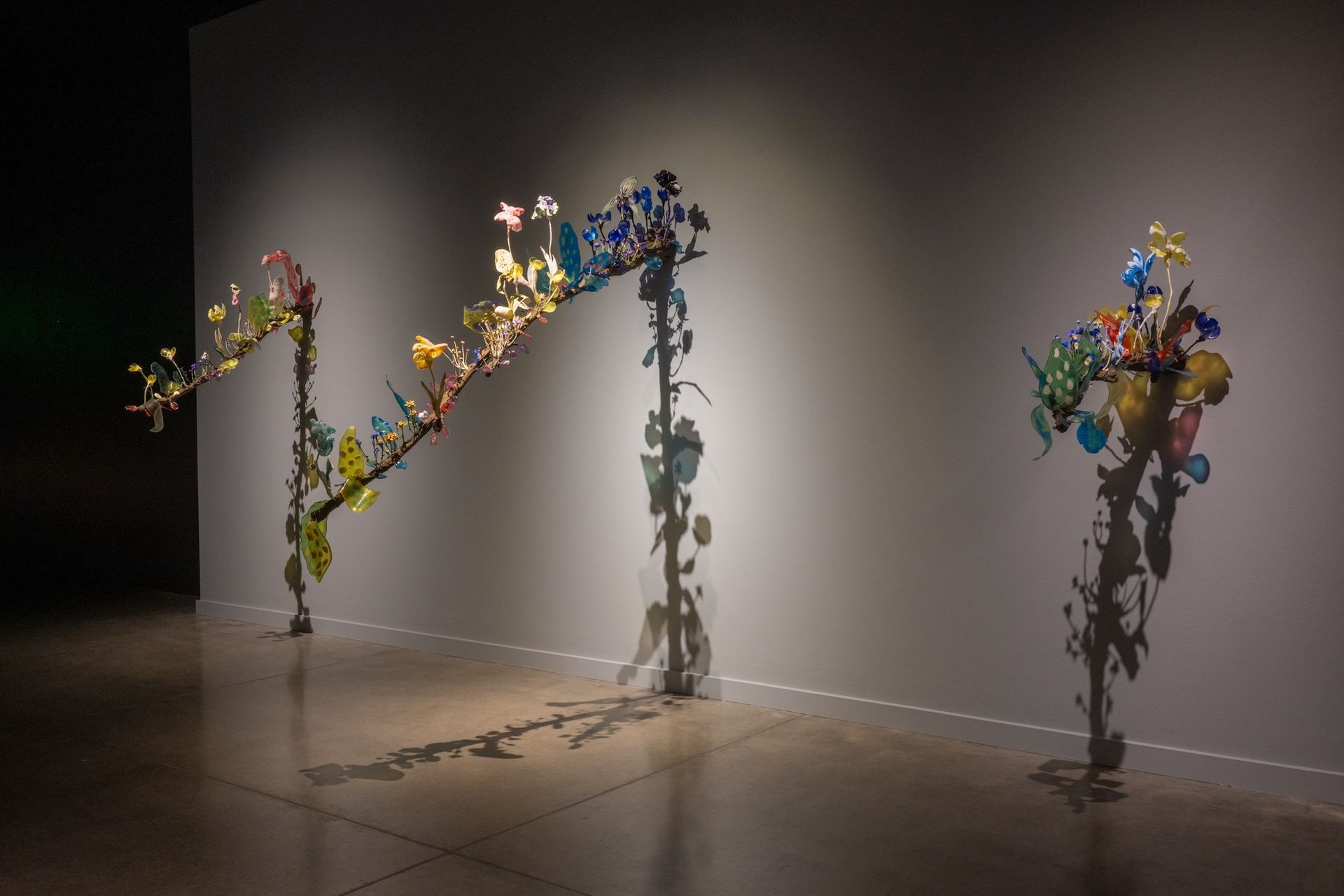
Installation view of Nathalie Djurberg & Hans Berg: A Place of Opportunity and Transformation, National Nordic Museum, Seattle Photo: Jim Bennett/Photo Bakery for the National Nordic Museum
Do you find it cathartic to create works all about desire, repulsion and shame? Does it ever get too emotional? Is there a point when you feel you have to stop?
ND: I made a few works where I almost haven’t been able to stay in the room, but it has felt so important that I’ve done it anyway. Also works that I questioned later, if I should have done them or not, but where it felt necessary to experience them while making them. But cathartic means that it’s brought up, felt and then let go of—and it’s not always the case that it’s let go of. Maybe part of it has been let go of and then comes up in an idea in a different way at a later time. But working does make me look at all those parts in myself. I am not able to make a work and not look at those things or feel them. However, since I became a mother, I have become more humble and more sensitive. So now the work takes slightly different paths. It’s interesting to me what has changed and how it seems now.
How about for you, Hans, with the music—having to pair it with these sometimes violent, disturbing scenes?
HB: I don’t find them that violent and disturbing…
ND: Yes you do! Oh, sorry.
HB: …but I remember one film, which I felt was very harsh. It wasn’t so violent, it was more the text in it. I had to do a very soothing and compassionate soundtrack for it, because it was too hard to watch otherwise. The music had to be like a blanket to hold onto. I felt that I could comfort the viewer—and myself—a little bit with the music. But sometimes I want to enhance the harshness. It’s not so much that it’s cathartic for me, but I do feel a lot with the films, and I put all my feelings into the music.
Do you find that the medium of stop-motion animation makes it easier to get through some of these very difficult topics?
ND: I think that both making stop motion and viewing it makes it easier. Making is where the art is. The process is the art for me, and I like having the overview and making much of it by myself. Otherwise I would miss the good part. It’s the complete opposite of a meal, because you have all the ingredients and you make it, but then you actually eat it in the end. Here, I’m eating it while I’m making it.
HB: And the films are made in chronological order. It’s not scene by scene cut together, which means Nathalie can change the direction at any time.
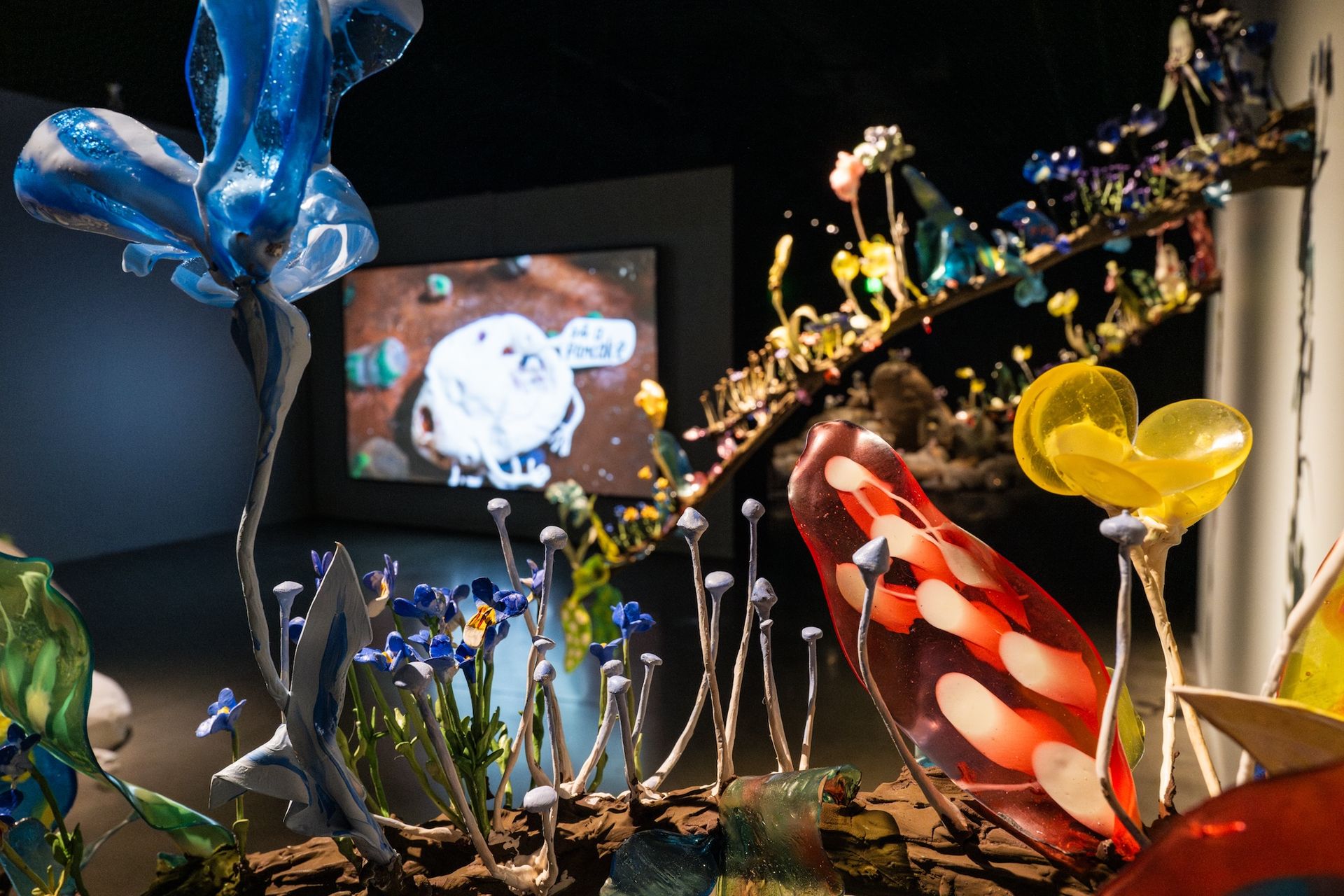
Installation view of Nathalie Djurberg & Hans Berg: A Place of Opportunity and Transformation, National Nordic Museum, Seattle Photo: Jim Bennett/Photo Bakery for the National Nordic Museum
The written text in your works is often in English. Do you always use English?
ND: It’s almost always English. For me, English is gratifying. I like it because it’s not my own language. I’m also dyslexic, so I don’t care if there are spelling mistakes. It isn’t about perfecting language, it’s about expressing the idea. I enjoy English very much. I watch all the American films. I only read books in English. Our interviews are mainly in English. When we have an interview in Sweden, for example, it’s very tricky—almost like we have to translate, not finding the words because the “art language” for us is English. It’s almost always English in the creative space too. The language gives me more freedom, because I don’t care about getting it completely right and I am a little bit removed from it. But cursing is pretty hard-wired—when I’m messing up in the studio, the curses are still in Swedish.
How has your work been received in different parts of the world? Is there a cultural component that comes into play depending on where it is shown?
ND: It’s usually pretty much the same everywhere. But one case that stood out for me was an exhibition in India some years ago, where people walked in from the street and started dancing. It became a disco, a dance club. I thought that was really beautiful. They were not trying to intellectualise the works, but viewing them, accepting what they were viewing and taking part by dancing. It’s easy to conceptualise things, and many times with art it’s so unnecessary. If we could explain something or pin it down exactly with words, it would be so much faster than making an artwork.
Is there a question you wish people would ask you more?
HB: It’s not a question, but I really enjoy when people tell us what they see in the works. If it’s something that we haven’t thought of, that’s really fascinating. People see aspects that we don’t see, and maybe they ask themselves what they bring to the work. The spectator always brings themselves and puts themselves in the work. It’s what connects people through art. Artists bring something and the spectators bring something, and I think that dialogue is very interesting.
- Nathalie Djurberg & Hans Berg: A Place of Opportunity and Transformation, until 27 October, National Nordic Museum, Seattle





